The Gold Burgers’ Cross of 1874
South Africa’s First Presidential Award - Part 2
Pierre H. Nortje

Introduction
In February last year (2024), the author wrote a paper on the gold Burgers’ Cross of 1874 that was published by the Western Cape Numismatic Society.
See The Gold Burger’s Cross of 1874: South Africa’s First Presidential Award
A few months ago, the author received very welcoming news regarding the cross and decided to write a short follow-up to his original paper.
Simultaneously, he stumbled upon something else of equal importance.
Background
After gold was discovered in the Eastern Transvaal in 1873, the area became known as the New Caledonia goldfields, later called Mac-Mac. Typhoid fever and malaria afflicted the diggers there, and two women distinguished themselves in nursing the sick.
Out of gratitude, the diggers made representations to the ZAR President Burgers that acknowledgement be shown to the two women. Both were awarded the Burger’s Cross. They were Mrs. Maria Magdalena Petronella Austin (née Espach) and Mrs. Anna Maria MacLachlan (née Shires)
It was not President Burgers’ intention to award the cross exclusively to nurses, because in 1877 the executive council (according to the late Matthy Esterhuysen) awarded the “Burgers Cross for Ladies” to Catharina Felicia van Rees, the Dutch poetess and composer of the Transvaal national anthem “Kent Gij dat Volk”.
However, sadly, in later years, only the whereabouts of one of the crosses was known, the one awarded to Maria Austin (née Espach).
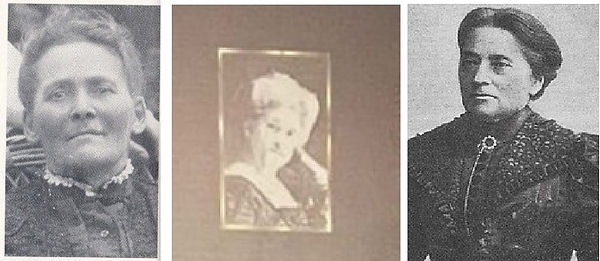
Left to right: Mrs. Maria Magdalena Petronella Austin (née Espach), Mrs. Anna Maria MacLachlan (née Shires) and Catharina Felicia van Rees.
According to a notice in the South African Digest (page 8) of 18 November 1983, a Burgers cross was at that stage in the possession of the Transvaal Provincial Administration. Their source is given as the Pretoria News of 21 October 1983.
We have written to Julia Montlha, a curator for the Numismatics collection at the Ditsong National Cultural History Museum in Pretoria, to ask if the cross is in their possession. She informed us on 12 December 2023 that she will check the item in question with the information provided and get back to us.
On 30 January 2024, she replied as follows…
“Unfortunately, we are unable to locate the record on our donation and acquisition database. I am currently searching the historical loss database and will inform you if it forms part of the objects stolen from the museum in the past years. However, I will keep the reference information and will contact you if anything comes up”.
The museum never contacted us again, and we assumed the cross was stolen, as was a replica in gold that was made by a descendant of President Burgers, Mr. Victor Burger, in 1973 and donated to the museum.
Recent turn of events
Recently, Professor Francois Malan from the University of Pretoria visited Pilgrim’s Rest and met a local historian there, René Reinders. She told him that as far as she knows, the Burger’s Cross that was awarded to Maria Austin (née Espach) is now in possession of the Mpumalanga Department of Culture, Sport and Recreation and kept in Nelspruit.
The following pictures were forwarded to Professor Malan, showing some gold items, including the cross and also the replica made by Mr. Victor Burger.
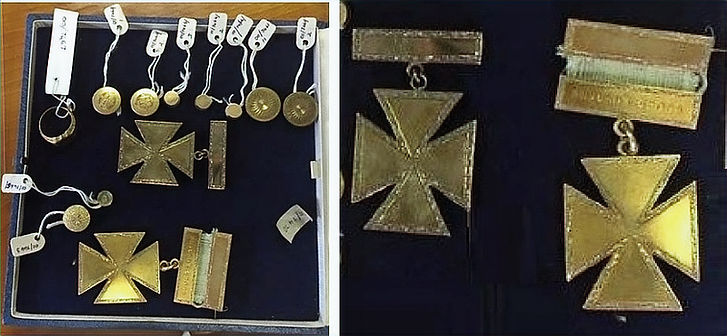
We believe that with the post-apartheid political dispensation in 1994, many items kept at the Ditsong museum were returned to the various provinces where they originated from, and so the crosses were handed back to the Mpumalanga Department of Culture, Sport and Recreation.
Incredibly, the Ditsong museum seems to have no knowledge of this.
Further Interesting News
Derick Rabe, the webmaster of the Western Cape Numismatic Society, recently forwarded the author some information regarding the Burgers’ Cross that he was not previously aware of while writing Part 1.
An autobiography on President Burgers, entitled Thomas Francois Burgers Staatspresident 1872 – 1877, was written by M.S. Appelgryn in 1979.
In his book, Appelgryn reveals a few interesting facts regarding the Burger’s Cross: -
The local diggers at Pilgrim’s Rest delegated a person by the name of G. Reston to Natal to have the crosses made by a certain Chadwick.
The cross of Mrs. Anna Maria MacLachlan was apparently set with a diamond.
Appelgryn gave his source for this information as an article entitled Het Burgerskruis that appeared in De Volksstem of 5.9.1874.
He also notes that the “Uitvoerende Raad” (Executive Council) indeed decided that a cross must be awarded to Catharina Felicia van Rees. His source is given as article 14 of the Executive Council’s Minutes of 11.4.1877. The decision was made a day before the ZAR was annexed by Great Britain, and the deputation that was destined for Europe was tasked with handing the cross to Van Rees.
In chapter VII of his memoirs, Paul Kruger writes that he, as vice president, led the deputation to London with Dr. Jorissen and Mr. W.E. Kok. In November 1877, the deputation left England and, on the homeward journey, visited Holland, France and Germany in August and October.
If the cross was indeed handed to Van Rees, it must have been done by Paul Kruger’s deputation. But we have no proof of this.
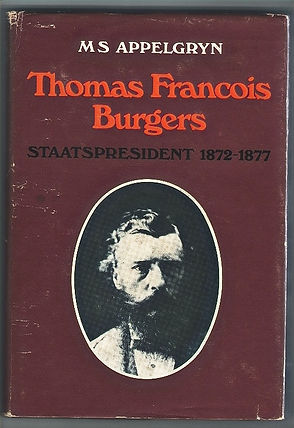
Transvaal Ere Kruis
It is widely thought that the first military medal awarded by a South African government was the Medalje voor de Anglo-Boere Oorlog, originally officially designated De Zuid-Afrikaanse Republiek- en Oranje Vrijstaat Oorlogsmedalje (the South African Republic and Orange Free State War Medal) and commonly referred to as the Anglo-Boere Oorlog Medalje.
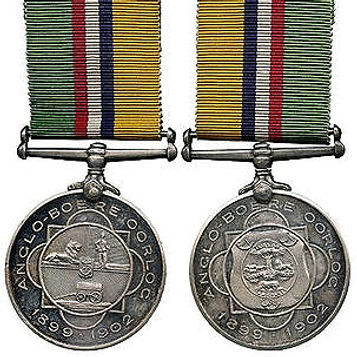
Source: WCNS
It was instituted in terms of Government Notice no. 2307 dated 21 December 1920, and published in the Union of South Africa Government Gazette of 24 December 1920.
It was a retrospective campaign medal for Boer veteran officers and men who served in the combat forces of the South African Republic and the Orange Free State during the Second Boer War.
In his book, Appelgryn mentions something that is extremely interesting: -
He writes that in June 1876, during the Sekhukhune (Sekoekoeni) war, the Volksraad approved a medal to be awarded for bravery and courage on the battlefield (Source: EVR 18, 8.6.1876).
The medal would be cast from Transvaal gold in the shape of a Maltese cross. On the front would be engraved the words "Voor Moed" (For Valour) and on the back "Trouw aan de Zuid-Afrikaansche Republiek" (Loyal to the ZAR).
In the middle of the cross would appear the recipient's name and the date. The ribbon of the cross would be in the form and colours of the Vierkleur (The National Flag), with the name of the place where the distinction was obtained in gold letters.
A recipient of the cross would be entitled to place the letters T.E.K. (Transvaal Ere Kruis = Transvaal Cross of Honour) after his signature and would be recognised as such in all official documents.
The establishment of the Cross of Honour is confirmed in the Transvaal Almanack of 1877, stating that the award was approved by the Volksraad on 8 June 1876.

Source: Derick Rabe
In 1901, the award was recalled by Proclamation 34 of that year, which was a foundational document for the legal system of the Transvaal Colony, establishing rules and procedures for legal proceedings and maintaining public order during a period of transition after the war.
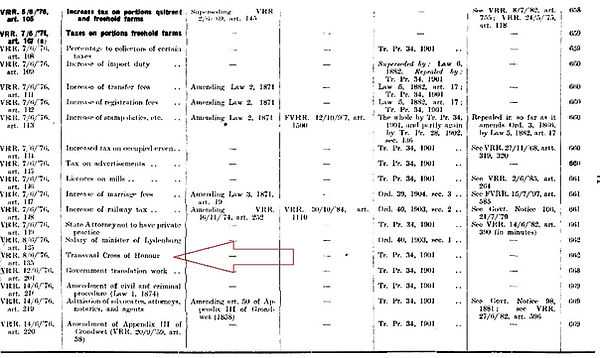
Source: Derick Rabe
In his book, Appelgryn says that as far as could be ascertained, only one Cross of Honour was awarded during Burgers' reign, as the Republic was annexed by Great Britain a few months later.
In Chapter 10, he describes how the Transvaal forces under General Nicolaas Smit, in early August 1876, stormed Chief Sekoekoenie’s headquarters but got pinned down due to heavy fire by the Pedi.

Sekhukhune (also known as Sekoekoenie) was the paramount King of the Marota, more commonly known as the Bapedi (Pedi people), until his assassination in 1882 by his rival and half-brother, Mampuru II.
Source: Wikipedia
Only Commandant Nel and Field Cornet S.J. Roos, with 40 men, bravely continued to advance and succeeded in reaching Sekhukhune headquarters and destroyed most of the huts. However, they were soon forced to retreat due to a lack of support from General Smit and the rest of his men.

Picture left of Stephanus Johannes Roos, one of the heroes of the Battle of Majuba. Picture right of his grave. (Source: Wikimedia). He died when he was only 38 years old, and both he and another officer, Frederik Senekal, were killed in the same skirmish. The town Roossenekal in the Limpopo province was named after them.
In a footnote (page 136), Appelgryn writes (translated from Afrikaans), “During the campaign, the first Transvaal Cross of Honour for bravery was awarded by the President. The recipient was probably Field Cornet Roos, who was immediately promoted to Commandant”.
This we find strange as in the First Anglo–Boer War (1880 - 1881) Stephanus Johannes Roos was still a Field Cornet. He died in that rank on February 28, 1883, in the war against chiefs Mampuru and Nyabela near Middelburg in southern Limpopo.
In his book entitled Thomas Francois Burgers, 'n Lewenskets (1933), Dr. S.P. Engelbrecht mentions some other “hero’s” of the war against Sekhukhune, including a certain Veldkornet Henning Pretorius.
Henning Petrus Nicolaas Pretorius was the son of Marthinus Wessel Pretorius, a cousin of the similarly named Transvaal State President and Debora Jacoba Retief, the daughter of the well-known Voortrekker leader Piet Retief.
In later years, he was promoted to Kommandant (Lieutenant Colonel) in charge of Transvaal State Artillery and died in 1897 shortly before the outbreak of the Anglo-Boer War.

Picture left of HPN Pretorius, also known as "Skote Petoors" (Source: Wikimedia). Picture right of his memorial stone (Source: Afrikanergeskiedenis.co.za)
However, as in the case of Roos, we could find no absolute proof that Pretorius, or any other soldier, was a recipient of the Transvaal Cross of Honour, but as it was indeed promulgated by the ZAR Government, it is without question our country’s first locally sanctioned military award.
It is strange that it seems to have been totally ignored by South African military historians.
